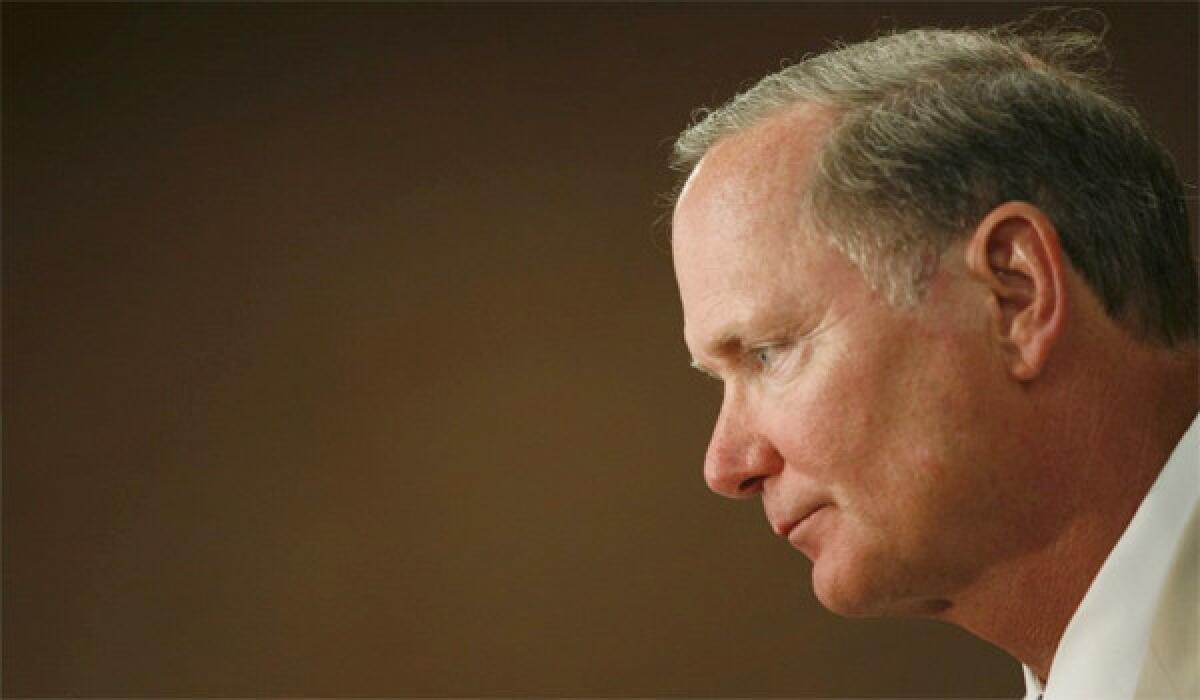TV pulls the strings for college football

- Share via
College football is upon us. Think of it as four months of tailgate parties and ESPN making bank deposits.
It will end in January at the Rose Bowl with Alabama playing somebody for the national title.
Pat Haden sits at his temporary desk in his temporary office in a shopping mall near the USC campus and declares, rather bravely, “I’m not the football director, I’m the athletic director.” A few minutes later, he shrugs and comes to his senses.
“I get it,” he says. “I know.”
He is in these temporary digs because the traditional athletic department home, Heritage Hall, is being remodeled, upgraded, slicked up a bit. Nothing wrong there. Why shouldn’t it be like the sport that supports it?
College football is booming. It’s a good show, compelling and unscripted entertainment. What used to be 1:30 every Saturday afternoon in the fall is now just about every day and night of the week, well into the winter. That’s because television has beckoned and college football has saluted. The colleges said show me the money, and ESPN did.
ESPN will televise about 450 games this season and 33 of the 35 bowl games, some of them named for things such as pizza or flowers. Doesn’t matter. ESPN has time to fill and money to do it. It has muscled its way into the power position of college sports because it can. And because college athletics has allowed it.
To quantify, the New York Times reported in a recent series that ESPN has pumped $5 billion into college football in the last five years. That’s billion with a B.
It is hard to take issue with good, old-fashioned American business enterprise, unless you are one of those egghead professors in a tweed coat, sucking on a pipe and complaining about a for-profit mega-business, one that operates from a questionable ethical base and often intrudes on the educational process.
Questionable ethics?
ESPN owns broadcast rights to many things it also covers as a news division. That works only if, when it pays millions to put something on the air, it also allows its reporters the freedom to report the good and the bad. ESPN will say it does. There have been plenty of examples that show it doesn’t.
Intrude on the educational process?
How well do you think those 8 p.m. games in Boise on a Thursday night worked with Friday’s 8 a.m. chemistry classes?
Haden is a perfect person to engage in a chat about this, because he not only gets it, but is smart (former Rhodes scholar), can see the business side of things (former partner in a highly successful private equity firm), can see the athletic side of things (former USC quarterback, Rose Bowl MVP and NFL quarterback), and can see the TV side of things (former network commentator).
Also, he gives it to you straight.
“The genie is out of the bottle,” he says.
He means that the days of Saturday afternoons at 1:30 and players missing practice because they had a chemistry lab are over. He means that the days of the school controlling game times and making decisions factoring in academics are over. He justifies — not that he needs to — the excesses of football as a means to balance the books for the rest of his athletic programs, which include 20 other sports and 650 athletes.
His annual budget is $80 million. He makes about $15.5 million of that from TV partnerships. That TV revenue may rise dramatically as Commissioner Larry Scott’s Pac-12 Networks finds traction. Football pays for all the other sports at USC, each of which loses money. Haden calls that a “broken business model.”
TV has made athletic directors into a kind of Yossarian in “Catch-22,” and Haden articulates that well.
“We want our cake, and we want to eat it,” he says. “We get paid, and then we complain about starting times.”
That is becoming a large issue. Of USC’s 12 remaining games this season, only five have a listed started time. Haden says he has one season-ticket holder who comes in for games from London. Another from Chicago.
“How do you book a flight?” he says.
His challenge, and that of many of his peers, is to find a way to compete with the very people who are funding him. He says high-definition TV is making the game so attractive that it becomes harder to get people off their couches.
“We have to find a way to make the game-day experience so good that they still want to come,” he says.
He says he recently learned that some of the telecasts will add two more commercial spots this season. He finds that a positive.
“It gives me two more chances to do something for the people in the stadium,” he says.
He has done well with that so far. USC led the conference in attendance last year, averaging about 83,000.
USC won its season opener in Hawaii on Thursday night. Yes, Thursday night. It was remarkably unremarkable. Ramifications ahead will not be.
Coach Lane Kiffin is probably on a short leash, although Haden won’t say that. The Trojans have two fairly equal quarterbacks, something often more problematic than advantageous.
And somewhere in Bristol, Conn., home of ESPN, a high-paid puppeteer is poised to pull a string that will somehow yank USC, and dozens of other teams.
Just because he or she can.
More to Read
Go beyond the scoreboard
Get the latest on L.A.'s teams in the daily Sports Report newsletter.
You may occasionally receive promotional content from the Los Angeles Times.











